Composites of Reduced Graphene Oxide Based on Silver Nanoparticles and Their Effect on Breast Cancer Stem Cells
Abstract
1. Introduction
2. Materials and Methods
2.1. Chemicals
2.2. Preparation of Silver Nanoparticles
2.3. Preparation of Graphene Oxide (GO) Sheets
2.4. Preparation of rGO via Thermal Reduction
2.5. Preparation of GO-Ag Nanocomposite
2.6. Preparation of rGO-Ag Nanocomposite
2.7. Characterization of Nanocomposites
2.8. Cell Viability Assay
2.9. Mammosphere Formation Assay
2.10. Quantitative RT-PCR
2.11. Statistical Analysis
3. Results
3.1. UV–Vis Spectroscopy
3.2. Powder X-Ray Diffraction (PXRD) Analysis
3.3. SEM Analysis
3.4. Fourier-Transform Infrared Spectroscopy (FTIR) Analysis
3.5. Raman Spectroscopy
3.6. Cell Viability Assay
3.7. Mammosphere Formation
3.8. Quantitative RT-PCR Analysis
4. Discussion
5. Conclusions
Author Contributions
Funding
Institutional Review Board Statement
Informed Consent Statement
Data Availability Statement
Acknowledgments
Conflicts of Interest
References
- Geim, A.K.; Novoselov, K.S. The Rise of Graphene. Nat. Mater. 2007, 6, 183–191. [Google Scholar] [CrossRef]
- Lee, C.H.; Hsue, Y.C.; Chen, R.B.; Li, T.S.; Lin, M.F. Electronic Structures of Finite Double-Walled Carbon Nanotubes in a Magnetic Field. J. Phys. Condens. Matter 2008, 20, 075213. [Google Scholar] [CrossRef]
- Novoselov, K.S.; Geim, A.K.; Morozov, S.V.; Jiang, D.; Zhang, Y.; Dubonos, S.V.; Grigorieva, I.V.; Firsov, A.A. Electric Field Effect in Atomically Thin Carbon Films. Science 2004, 306, 666–669. [Google Scholar] [CrossRef] [PubMed]
- Stoller, M.D.; Park, S.; Zhu, Y.; An, J.; Ruoff, R.S. Graphene-Based Ultracapacitors. Nano Lett. 2008, 8, 3498–3502. [Google Scholar] [CrossRef]
- Lekshmi, G.S.; Tamilselvi, R.; Geethalakshmi, R.; Kirupha, S.D.; Bazaka, O.; Levchenko, I.; Bazaka, K.; Mandhakini, M. Multifunctional Oil-Produced Reduced Graphene Oxide—Silver Oxide Composites with Photocatalytic, Antioxidant, and Antibacterial Activities. J. Colloid Interface Sci. 2022, 608 Pt 1, 294–305. [Google Scholar] [CrossRef]
- Khan, J.M.; Kurchania, R.; Sethi, V.K. Synthesis and Characterization of Two Dimensional Graphene Lamellae Based Pan Nanocomposites. Thin Solid Film. 2010, 519, 1059–1065. [Google Scholar] [CrossRef]
- Sagadevan, S.; Rahman, Z.; Léonard, E.; Losic, D.; Hessel, V. Sensor to Electronics Applications of Graphene Oxide through Azo Grafting. Nanomaterials 2023, 13, 846. [Google Scholar] [CrossRef]
- Li, D.; Müller, M.B.; Gilje, S.; Kaner, R.B.; Wallace, G.G. Processable Aqueous Dispersions of Graphene Nanosheets. Nat. Nanotechnol. 2008, 3, 101–105. [Google Scholar] [CrossRef]
- Mumtaz, M.A.; Afzal, A.M.; Iqbal, M.W.; Ifseisi, A.A.; Mumtaz, S.; Imran, M.; Usman, M.; Hussain, Z.; Waris, M.H.; Lamichhane, P. Enhancing the Charge Transfer and Redox Characteristics in Energy Storage Devices with a Layered Znnbs@Graphene Nanocomposite Electrode Material for Biomedical Application. Diam. Relat. Mater. 2023, 140, 110519. [Google Scholar] [CrossRef]
- Babu, B.R.; Sasikumar, R.; Arivanandhan, M.; Jayavel, R. Functionalised Carbon Fiber Based Flexible Symmetric Supercapacitors with Wider Potential Window for Sustainable Energy Storage Applications. J. Power Sources 2024, 625, 235727. [Google Scholar] [CrossRef]
- Seonwoo, H.; Choung, H.W.; Park, S.; Choi, K.S.; Jang, K.J.; Kim, J.; Lim, K.T.; Kim, Y.; Garg, P.; Pandey, S.; et al. Reduced Graphene Oxide-Incorporated Calcium Phosphate Cements with Pulsed Electromagnetic Fields for Bone Regeneration. RSC Adv. 2022, 12, 5557–5570. [Google Scholar] [CrossRef] [PubMed]
- Li, R.; Wang, Y.; Du, J.; Wang, X.; Duan, A.; Gao, R.; Liu, J.; Li, B. Graphene Oxide Loaded with Tumor-Targeted Peptide and Anti-Cancer Drugs for Cancer Target Therapy. Sci. Rep. 2021, 11, 1725. [Google Scholar] [CrossRef]
- Croitoru, A.-M.; Moroșan, A.; Tihăuan, B.; Oprea, O.; Motelică, L.; Trușcă, R.; Nicoară, A.I.; Popescu, R.-C.; Savu, D.; Mihăiescu, D.E.; et al. Novel Graphene Oxide/Quercetin and Graphene Oxide/Juglone Nanostructured Platforms as Effective Drug Delivery Systems with Biomedical Applications. Nanomaterials 2022, 12, 1943. [Google Scholar] [CrossRef] [PubMed]
- Sun, X.; Liu, Z.; Welsher, K.; Robinson, J.T.; Goodwin, A.; Zaric, S.; Dai, H. Nano-Graphene Oxide for Cellular Imaging and Drug Delivery. Nano Res. 2008, 1, 203–212. [Google Scholar] [CrossRef] [PubMed]
- Lu, H.; Li, W.; Qiu, P.; Zhang, X.; Qin, J.; Cai, Y.; Lu, X. Mno(2) Doped Graphene Nanosheets for Carotid Body Tumor Combination Therapy. Nanoscale Adv. 2022, 4, 4304–4313. [Google Scholar] [CrossRef]
- Sanchez, J.A.; Materon, L.; Parsons, J.G.; Alcoutlabi, M. Synthesis, Characterization, and Antibacterial Activity of Graphene Oxide/Zinc Hydroxide Nanocomposites. Appl. Sci. 2024, 14, 6274. [Google Scholar] [CrossRef]
- Elbasuney, S.; Yehia, M.; Ismael, S.; Al-Hazmi, N.E.; El-Sayyad, G.S.; Tantawy, H. Potential Impact of Reduced Graphene Oxide Incorporated Metal Oxide Nanocomposites as Antimicrobial, and Antibiofilm Agents against Pathogenic Microbes: Bacterial Protein Leakage Reaction Mechanism. J. Clust. Sci. 2023, 34, 823–840. [Google Scholar] [CrossRef]
- Hua, F.; Yao, T.; Yao, Y. Spherical Silver Nanoparticles Located on Reduced Graphene Oxide Nanocomposites as Sensitive Electrochemical Sensors for Detection of L-Cysteine. Sensors 2024, 24, 1789. [Google Scholar] [CrossRef]
- Lu, C.; Yang, H.; Zhu, C.; Chen, X.; Chen, G. A Graphene Platform for Sensing Biomolecules. Angew. Chem. Int. Ed. Engl. 2009, 48, 4785–4787. [Google Scholar] [CrossRef]
- Sattari, S.; Adeli, M.; Beyranvand, S.; Nemati, M. Functionalized Graphene Platforms for Anticancer Drug Delivery. Int. J. Nanomed. 2021, 16, 5955–5980. [Google Scholar] [CrossRef]
- Yaghoubi, F.; Motlagh, N.S.H.; Naghib, S.M.; Haghiralsadat, F.; Jaliani, H.Z.; Moradi, A. A Functionalized Graphene Oxide with Improved Cytocompatibility for Stimuli-Responsive Co-Delivery of Curcumin and Doxorubicin in Cancer Treatment. Sci. Rep. 2022, 12, 1959. [Google Scholar] [CrossRef] [PubMed]
- Akhavan, O.; Ghaderi, E.; Aghayee, S.; Fereydooni, Y.; Talebi, A. The Use of a Glucose-Reduced Graphene Oxide Suspension for Photothermal Cancer Therapy. J. Mater. Chem. 2012, 22, 13773–13781. [Google Scholar] [CrossRef]
- Fiorillo, M.; Verre, A.F.; Iliut, M.; Peiris-Pagés, M.; Ozsvari, B.; Gandara, R.; Cappello, A.R.; Sotgia, F.; Vijayaraghavan, A.; Lisanti, M.P. Graphene Oxide Selectively Targets Cancer Stem Cells, across Multiple Tumor Types: Implications for Non-Toxic Cancer Treatment, Via “Differentiation-Based Nano-Therapy”. Oncotarget 2015, 6, 3553–3562. [Google Scholar] [CrossRef]
- Gurunathan, S.; Han, J.W.; Eppakayala, V.; Kim, J.-H. Green Synthesis of Graphene and Its Cytotoxic Effects in Human Breast Cancer Cells. Int. J. Nanomed. 2013, 8, 1015–1027. [Google Scholar] [CrossRef]
- Gurunathan, S.; Han, J.; Park, J.H.; Kim, J.H. An in Vitro Evaluation of Graphene Oxide Reduced by Ganoderma Spp. In Human Breast Cancer Cells (Mda-Mb-231). Int. J. Nanomed. 2014, 9, 1783–1797. [Google Scholar] [CrossRef]
- Aparicio-Collado, J.; García-San-Martín, N.; Molina-Mateo, J.; Cabanilles, C.T.; Quiles, V.D.; Serrano-Aroca, A.; i Serra, R.S. Electroactive Calcium-Alginate/Polycaprolactone/Reduced Graphene Oxide Nanohybrid Hydrogels for Skeletal Muscle Tissue Engineering. Colloids Surf. B Biointerfaces 2022, 214, 112455. [Google Scholar] [CrossRef] [PubMed]
- Gurunathan, S.; Kim, J.K. Synthesis, Toxicity, Biocompatibility, and Biomedical Applications of Graphene and Graphene-Related Materials. Int. J. Nanomed. 2016, 11, 1927–1945. [Google Scholar] [CrossRef] [PubMed]
- Zhang, Y.; Ali, S.F.; Dervishi, E.; Xu, Y.; Li, Z.; Casciano, D.; Biris, A.S. Cytotoxicity Effects of Graphene and Single-Wall Carbon Nanotubes in Neural Phaeochromocytoma-Derived Pc12 Cells. ACS Nano 2010, 4, 3181–3186. [Google Scholar] [CrossRef]
- Li, N.; Zhang, X.; Song, Q.; Su, R.; Zhang, Q.; Kong, T.; Liu, L.; Jin, G.; Tang, M.; Cheng, G. The Promotion of Neurite Sprouting and Outgrowth of Mouse Hippocampal Cells in Culture by Graphene Substrates. Biomaterials 2011, 32, 9374–9382. [Google Scholar] [CrossRef]
- Luo, Y.; Shen, H.; Fang, Y.; Cao, Y.; Huang, J.; Zhang, M.; Dai, J.; Shi, X.; Zhang, Z. Enhanced Proliferation and Osteogenic Differentiation of Mesenchymal Stem Cells on Graphene Oxide-Incorporated Electrospun Poly(Lactic-Co-Glycolic Acid) Nanofibrous Mats. ACS Appl. Mater. Interfaces 2015, 7, 6331–6339. [Google Scholar] [CrossRef]
- Garcia-Alegria, E.; Iliut, M.; Stefanska, M.; Silva, C.; Heeg, S.; Kimber, S.J.; Kouskoff, V.; Lacaud, G.; Vijayaraghavan, A.; Batta, K. Graphene Oxide Promotes Embryonic Stem Cell Differentiation to Haematopoietic Lineage. Sci. Rep. 2016, 6, 25917. [Google Scholar] [CrossRef] [PubMed]
- Stensberg, M.C.; Wei, Q.; McLamore, E.S.; Porterfield, D.M.; Wei, A.; Sepúlveda, M.S. Toxicological Studies on Silver Nanoparticles: Challenges and Opportunities in Assessment, Monitoring and Imaging. Nanomedicine 2011, 6, 879–898. [Google Scholar] [CrossRef] [PubMed]
- Christopher, P.; Linic, S. Engineering Selectivity in Heterogeneous Catalysis: Ag Nanowires as Selective Ethylene Epoxidation Catalysts. J. Am. Chem. Soc. 2008, 130, 11264–11265. [Google Scholar] [CrossRef]
- Sriram, M.I.; Kanth, S.B.M.; Kalishwaralal, K.; Gurunathan, S. Antitumor Activity of Silver Nanoparticles in Dalton’s Lymphoma Ascites Tumor Model. Int. J. Nanomed. 2010, 5, 753–762. [Google Scholar]
- AshaRrani, P.V.; Low Kah Mun, G.; Hande, M.P.; Valiyaveettil, S. Cytotoxicity and Genotoxicity of Silver Nanoparticles in Human Cells. ACS Nano 2009, 3, 279–290. [Google Scholar] [CrossRef]
- Kalishwaralal, K.; BarathManiKanth, S.; Pandian, S.R.K.; Deepak, V.; Gurunathan, S. Silver Nano—A Trove for Retinal Therapies. J. Control. Release 2010, 145, 76–90. [Google Scholar] [CrossRef]
- Liu, L.; Liu, J.; Wang, Y.; Yan, X.; Sun, D.D. Facile Synthesis of Monodispersed Silver Nanoparticles on Graphene Oxide Sheets with Enhanced Antibacterial Activity. New J. Chem. 2011, 35, 1418–1423. [Google Scholar] [CrossRef]
- You, J.-M.; Kim, D.; Jeon, S. Electrocatalytic Reduction of H2O2 on Thiolate Graphene Oxide Covalently to Bonded Palladium Nanoparticles. J. Nanosci. Nanotechnol. 2012, 12, 3943–3949. [Google Scholar] [CrossRef]
- Zhu, Y.-G.; Cao, G.-S.; Sun, C.-Y.; Xie, J.; Liu, S.-Y.; Zhu, T.-J.; Zhao, X.B.; Yang, H.Y. Design and Synthesis of Nio Nanoflakes/Graphene Nanocomposite as High Performance Electrodes of Pseudocapacitor. RSC Adv. 2013, 3, 19409–19415. [Google Scholar] [CrossRef]
- Dat, N.M.; Long, P.N.B.; Nhi, D.C.U.; Minh, N.N.; Duy, L.M.; Quan, L.N.; Nam, H.M.; Phong, M.T.; Hieu, N.H. Synthesis of Silver/Reduced Graphene Oxide for Antibacterial Activity and Catalytic Reduction of Organic Dyes. Synth. Met. 2020, 260, 116260. [Google Scholar] [CrossRef]
- de Luna, L.A.V.; de Moraes, A.C.M.; Consonni, S.R.; Pereira, C.D.; Cadore, S.; Giorgio, S.; Alves, O.L. Comparative in Vitro Toxicity of a Graphene Oxide-Silver Nanocomposite and the Pristine Counterparts toward Macrophages. J. Nanobiotechnol. 2016, 14, 12. [Google Scholar] [CrossRef] [PubMed]
- Gurunathan, S.; Kim, J.-H. Graphene Oxide-Silver Nanoparticles Nanocomposite Stimulates Differentiation in Human Neuroblastoma Cancer Cells (Sh-Sy5y). Int. J. Mol. Sci. 2017, 18, 2549. [Google Scholar] [CrossRef] [PubMed]
- Nageshwaran, S.; Majumdar, K.; Russell, S. Hypergammaglobulinemia, Normal Serum Albumin and Hypercalcaemia: A Case of Systemic Sarcoidosis with Initial Diagnostic Confusion. BMJ Case Rep. 2012, 2012, bcr0120125478. [Google Scholar] [CrossRef] [PubMed]
- Rao, V.H.; Kandel, A.; Lynch, D.; Pena, Z.; Marwaha, N.; Deng, C.; Watson, P.; Hansen, L.A. A Positive Feedback Loop between Her2 and Adam12 in Human Head and Neck Cancer Cells Increases Migration and Invasion. Oncogene 2011, 31, 2888–2898. [Google Scholar] [CrossRef]
- Ediriwickrema, A.; Saltzman, W.M. Nanotherapy for Cancer: Targeting and Multifunctionality in the Future of Cancer Therapies. ACS Biomater. Sci. Eng. 2015, 1, 64–78. [Google Scholar] [CrossRef]
- Sun, L.; Liu, H.; Ye, Y.; Lei, Y.; Islam, R.; Tan, S.; Tong, R.; Miao, Y.B.; Cai, L. Smart Nanoparticles for Cancer Therapy. Signal Transduct. Target. Ther. 2023, 8, 418. [Google Scholar] [CrossRef]
- Pryshchepa, O.; Pomastowski, P.; Buszewski, B. Silver Nanoparticles: Synthesis, Investigation Techniques, and Properties. Adv. Colloid Interface Sci. 2020, 284, 102246. [Google Scholar] [CrossRef]
- Bressan, E.; Ferroni, L.; Gardin, C.; Sbricoli, L.; Gobbato, L.; Ludovichetti, F.S.; Tocco, I.; Carraro, A.; Piattelli, A.; Zavan, B. Graphene Based Scaffolds Effects on Stem Cells Commitment. J. Transl. Med. 2014, 12, 296. [Google Scholar] [CrossRef]
- Bousiakou, L.G.; Qindeel, R.; Al-Dossary, O.M.; Kalkani, H. Synthesis and Characterization of Graphene Oxide (Go) Sheets for Pathogen Inhibition: Escherichia Coli, Staphylococcus Aureus and Pseudomonas Aeruginosa. J. King Saud Univ.-Sci. 2022, 34, 102002. [Google Scholar] [CrossRef]
- Klemeyer, L.; Park, H.; Huang, J. Geometry-Dependent Thermal Reduction of Graphene Oxide Solid. ACS Mater. Lett. 2021, 3, 511–515. [Google Scholar] [CrossRef]
- Hassen, A.; Moawed, E.A.; Bahy, R.; El Basaty, A.B.; El-Sayed, S.; Ali, A.I.; Tayel, A. Synergistic Effects of Thermally Reduced Graphene Oxide/Zinc Oxide Composite Material on Microbial Infection for Wound Healing Applications. Sci. Rep. 2024, 14, 22942. [Google Scholar] [CrossRef]
- Yuan, Y.-G.; Wang, Y.-H.; Xing, H.-H.; Gurunathan, S. Quercetin-Mediated Synthesis of Graphene Oxide-Silver Nanoparticle Nanocomposites: A Suitable Alternative Nanotherapy for Neuroblastoma. Int. J. Nanomed. 2017, 12, 5819–5839. [Google Scholar] [CrossRef] [PubMed]
- Gurunathan, S.; Han, J.W.; Eppakayala, V.; Kim, J.-H. Biocompatibility of Microbially Reduced Graphene Oxide in Primary Mouse Embryonic Fibroblast Cells. Colloids Surf B Biointerfaces 2013, 105, 58–66. [Google Scholar] [CrossRef] [PubMed]
- Elias, M.; Alam, R.; Sarker, S.; Hossain, M.A. Fabrication of Ag-Doped Biof-Reduced Graphene Oxide Composites for Photocatalytic Elimination of Organic Dyes. Heliyon 2024, 10, e34921. [Google Scholar] [CrossRef] [PubMed]
- Kumari, S.; Sharma, P.; Yadav, S.; Kumar, J.; Vij, A.; Rawat, P.; Kumar, S.; Sinha, C.; Bhattacharya, J.; Srivastava, C.M.; et al. A Novel Synthesis of the Graphene Oxide-Silver (Go-Ag) Nanocomposite for Unique Physiochemical Applications. ACS Omega 2020, 5, 5041–5047. [Google Scholar] [CrossRef]
- Shen, J.; Shi, M.; Li, N.; Yan, B.; Ma, H.; Hu, Y.; Ye, M. Facile Synthesis and Application of Ag-Chemically Converted Graphene Nanocomposite. Nano Res. 2010, 3, 339–349. [Google Scholar] [CrossRef]
- Al-Marri, A.H.; Khan, M.; Khan, M.; Adil, S.F.; Al-Warthan, A.; Alkhathlan, H.Z.; Tremel, W.; Labis, J.P.; Siddiqui, M.R.H.; Tahir, M.N. Pulicaria Glutinosa Extract: A Toolbox to Synthesize Highly Reduced Graphene Oxide-Silver Nanocomposites. Int. J. Mol. Sci. 2015, 16, 1131–1142. [Google Scholar] [CrossRef]
- Hu, C.; Liu, Y.; Qin, J.; Nie, G.; Lei, B.; Xiao, Y.; Zheng, M.; Rong, J. Fabrication of Reduced Graphene Oxide and Sliver Nanoparticle Hybrids for Raman Detection of Absorbed Folic Acid: A Potential Cancer Diagnostic Probe. ACS Appl. Mater. Interfaces 2013, 5, 4760–4768. [Google Scholar] [CrossRef]
- Choi, Y.-J.; Gurunathan, S.; Kim, J.-H. Graphene Oxide-Silver Nanocomposite Enhances Cytotoxic and Apoptotic Potential of Salinomycin in Human Ovarian Cancer Stem Cells (Ovcscs): A Novel Approach for Cancer Therapy. Int. J. Mol. Sci. 2018, 19, 710. [Google Scholar] [CrossRef]
- Ali, M.H.; Azad, M.A.K.; Khan, K.A.; Rahman, M.O.; Chakma, U.; Kumer, A. Analysis of Crystallographic Structures and Properties of Silver Nanoparticles Synthesized Using Pkl Extract and Nanoscale Characterization Techniques. ACS Omega 2023, 8, 28133–28142. [Google Scholar] [CrossRef]
- Priyadarsini, A.; Mohanty, C.; Nanda, S.; Mishra, A.; Das, N.; Swain, N.; Dash, M.; Jena, P.K. Synergistic Cobalt Oxide/Reduced Graphene Oxide/Biochar Nano-Composite Catalyst: Harnessing the Power of the Catalyst for Sustainable Remediation of Organic Dyes and Chromium(Vi). RSC Adv. 2024, 14, 10089–10103. [Google Scholar] [CrossRef] [PubMed]
- Anaklı, D.; Erşan, M. Optimization of Reduced Graphene Oxide Yield Using Response Surface Methodology. Diam. Relat. Mater. 2024, 148, 111524. [Google Scholar] [CrossRef]
- Devanshi, C.; Geetha, A.; Ilangovar, I.G.K.; Vasugi, S.; Balachandran, S.; Suresh, V.; Subramanian, B. Graphene-Functionalized Titanium Carbide Synthesis and Characterization and Its Cytotoxic Effect on Cancer Cell Lines. Cureus 2024, 16, e61049. [Google Scholar]
- He, Y.; Chen, W.; Gao, C.; Zhou, J.; Li, X.; Xie, E. An Overview of Carbon Materials for Flexible Electrochemical Capacitors. Nanoscale 2013, 5, 8799–8820. [Google Scholar] [CrossRef]
- Zuo, P.P.; Feng, H.F.; Xu, Z.Z.; Zhang, L.F.; Zhang, Y.L.; Xia, W.; Zhang, W.Q. Fabrication of Biocompatible and Mechanically Reinforced Graphene Oxide-Chitosan Nanocomposite Films. Chem. Cent. J. 2013, 7, 39. [Google Scholar] [CrossRef]
- Chook, S.W.; Chia, C.H.; Zakaria, S.; Ayob, M.K.; Chee, K.L.; Huang, N.M.; Neoh, H.M.; Lim, H.N.; Jamal, R.; Rahman, R. Antibacterial Performance of Ag Nanoparticles and Aggo Nanocomposites Prepared Via Rapid Microwave-Assisted Synthesis Method. Nanoscale Res. Lett. 2012, 7, 541. [Google Scholar] [CrossRef]
- Krishnaraj, C.; Radhakrishnan, S.; Asmare, M.M.; Wahab, S.; Kim, B.-S.; Yun, S.-I. Green Synthesis of Ag and Au Nps Decorated Rgo Nanocomposite for High Impedimetric Electrochemical Sensor as Well as Enhanced Antimicrobial Performance against Foodborne Pathogens. Arab. J. Chem. 2024, 17, 105379. [Google Scholar] [CrossRef]
- Yuan, X.; Chai, Y.; Yuan, R.; Zhao, Q.; Yang, C. Functionalized Graphene Oxide-Based Carbon Paste Electrode for Potentiometric Detection of Copper Ion(Ii). Anal. Methods 2012, 10, 3332–3337. [Google Scholar] [CrossRef]
- Giovanni, M.; Poh, H.L.; Ambrosi, A.; Zhao, G.; Sofer, Z.; Šaněk, F.; Khezri, B.; Webster, R.D.; Pumera, M. Noble Metal (Pd, Ru, Rh, Pt, Au, Ag) Doped Graphene Hybrids for Electrocatalysis. Nanoscale 2012, 4, 5002–5008. [Google Scholar] [CrossRef]
- Yuan, Y.-G.; Cai, H.-Q.; Wang, J.-L.; Mesalam, A.; Reza, A.M.M.T.; Li, L.; Chen, L.; Qian, C. Graphene Oxide-Silver Nanoparticle Nanocomposites Induce Oxidative Stress and Aberrant Methylation in Caprine Fetal Fibroblast Cells. Cells 2021, 10, 682. [Google Scholar] [CrossRef]
- Sadiq, H.; Sadiq, H.; Sohail, A.; Basit, A.; Akhtar, N.; Batool, K.; Hisaindee, S.; Asghar, L. Assessment of Antioxidant Activity of Pure Graphene Oxide (Go) and Composite V2O5/Go Using Dpph Radical and H2O2 Scavenging Assays. J. Sol-Gel Sci. Technol. 2023, 108, 840–849. [Google Scholar] [CrossRef]
- Kaur, R.; Singh, K.; Agarwal, S.; Masih, M.; Chauhan, A.; Gautam, P.K. Silver Nanoparticles Induces Apoptosis of Cancer Stem Cells in Head and Neck Cancer. Toxicol. Rep. 2024, 12, 10–17. [Google Scholar] [CrossRef] [PubMed]
- Dasari, N.; Guntuku, G.S.; Pindiprolu, S.K.S. Targeting Triple Negative Breast Cancer Stem Cells Using Nanocarriers. Discov Nano 2024, 19, 41. [Google Scholar] [CrossRef] [PubMed]
- Rajanahalli, P.; Stucke, C.J.; Hong, Y. The Effects of Silver Nanoparticles on Mouse Embryonic Stem Cell Self-Renewal and Proliferation. Toxicol. Rep. 2015, 2, 758–764. [Google Scholar] [CrossRef]
- Gao, X.; Li, R.; Yourick, J.J.; Sprando, R.L. Transcriptomic and Proteomic Responses of Silver Nanoparticles in Hepatocyte-Like Cells Derived from Human Induced Pluripotent Stem Cells. Toxicol Vitr. 2022, 79, 105274. [Google Scholar] [CrossRef]
- Wierzbicki, M.; Hotowy, A.; Kutwin, M.; Jaworski, S.; Bałaban, J.; Sosnowska, M.; Wójcik, B.; Wędzińska, A.; Chwalibog, A.; Sawosz, E. Graphene Oxide Scaffold Stimulates Differentiation and Proangiogenic Activities of Myogenic Progenitor Cells. Int. J. Mol. Sci. 2020, 21, 4173. [Google Scholar] [CrossRef]
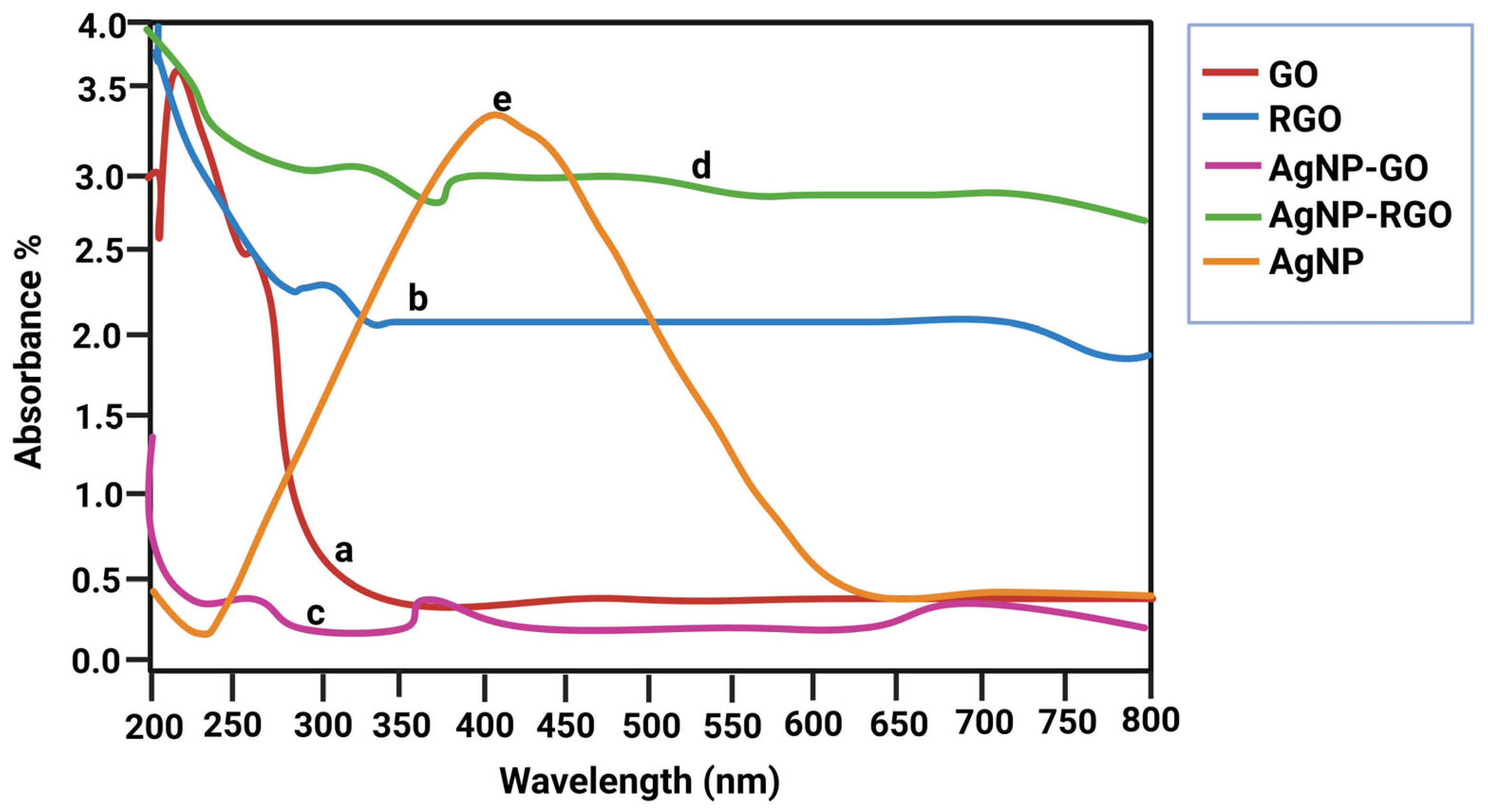
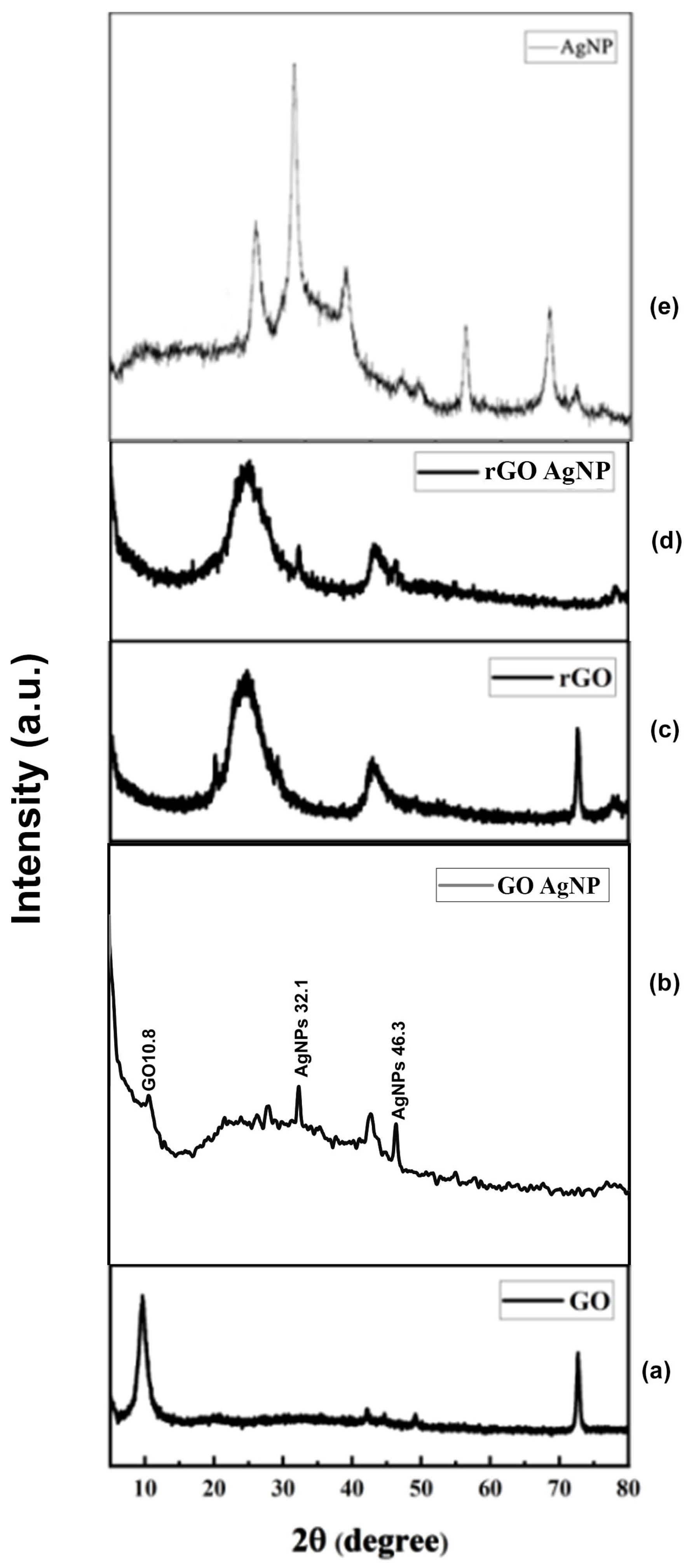
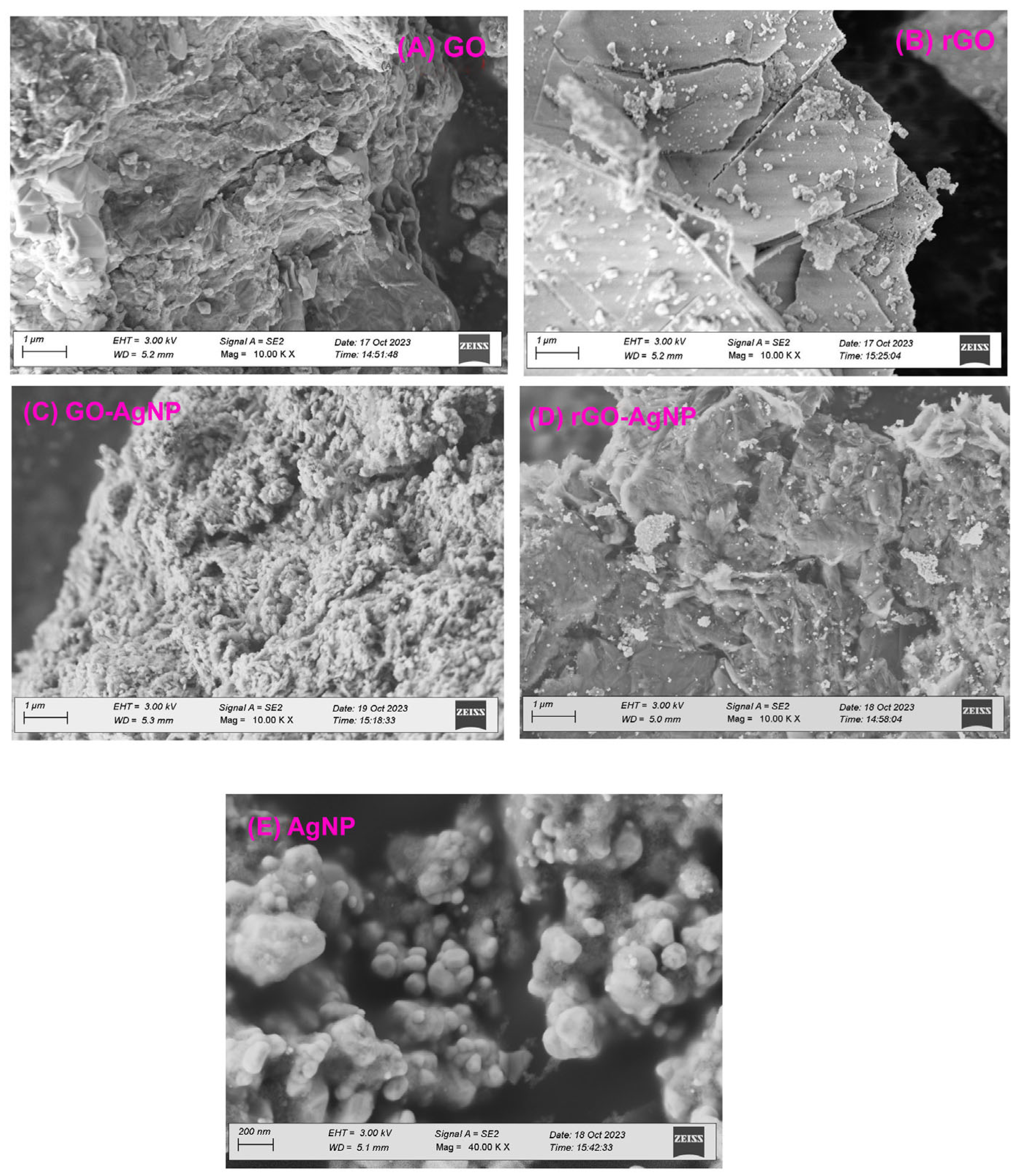
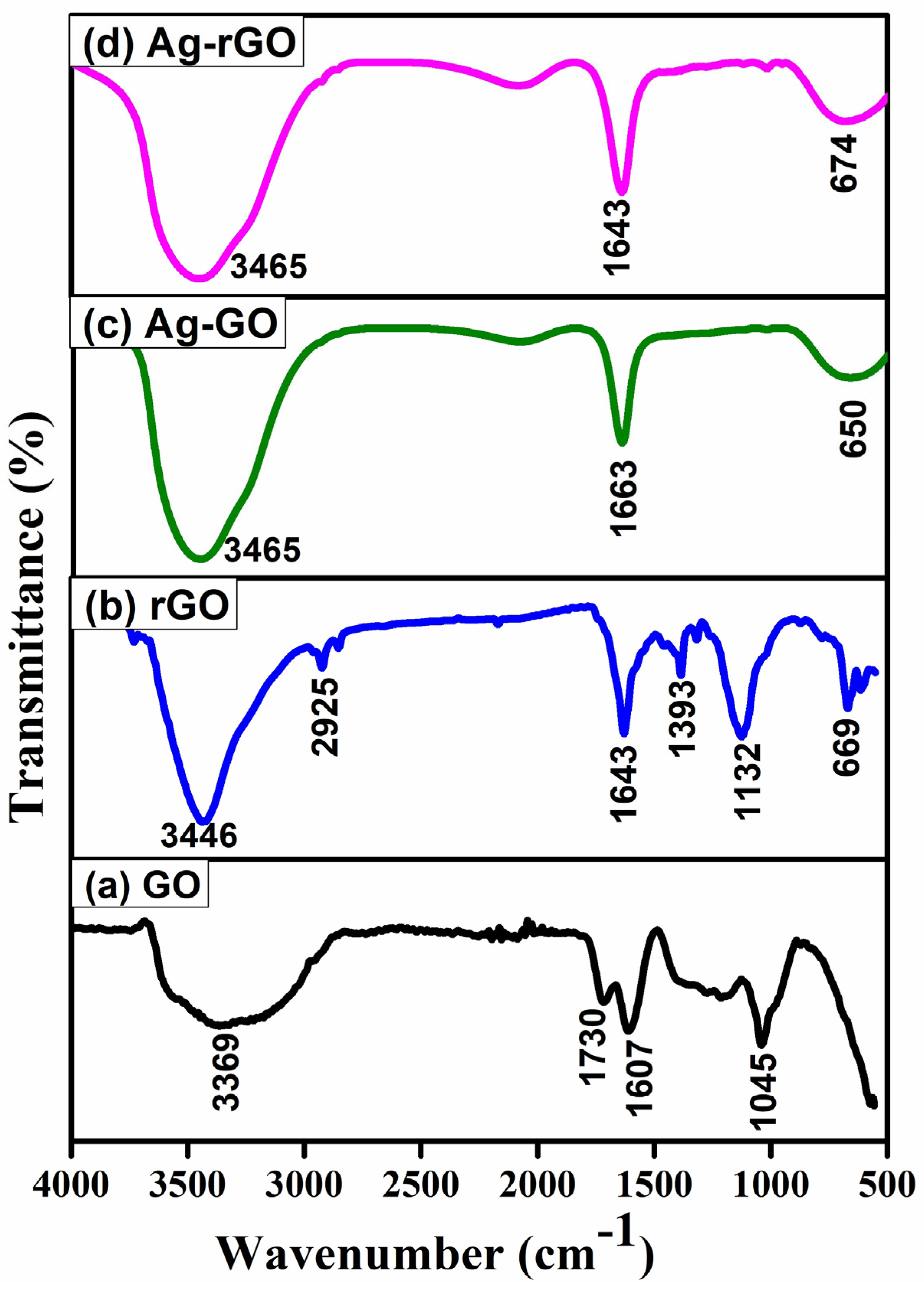
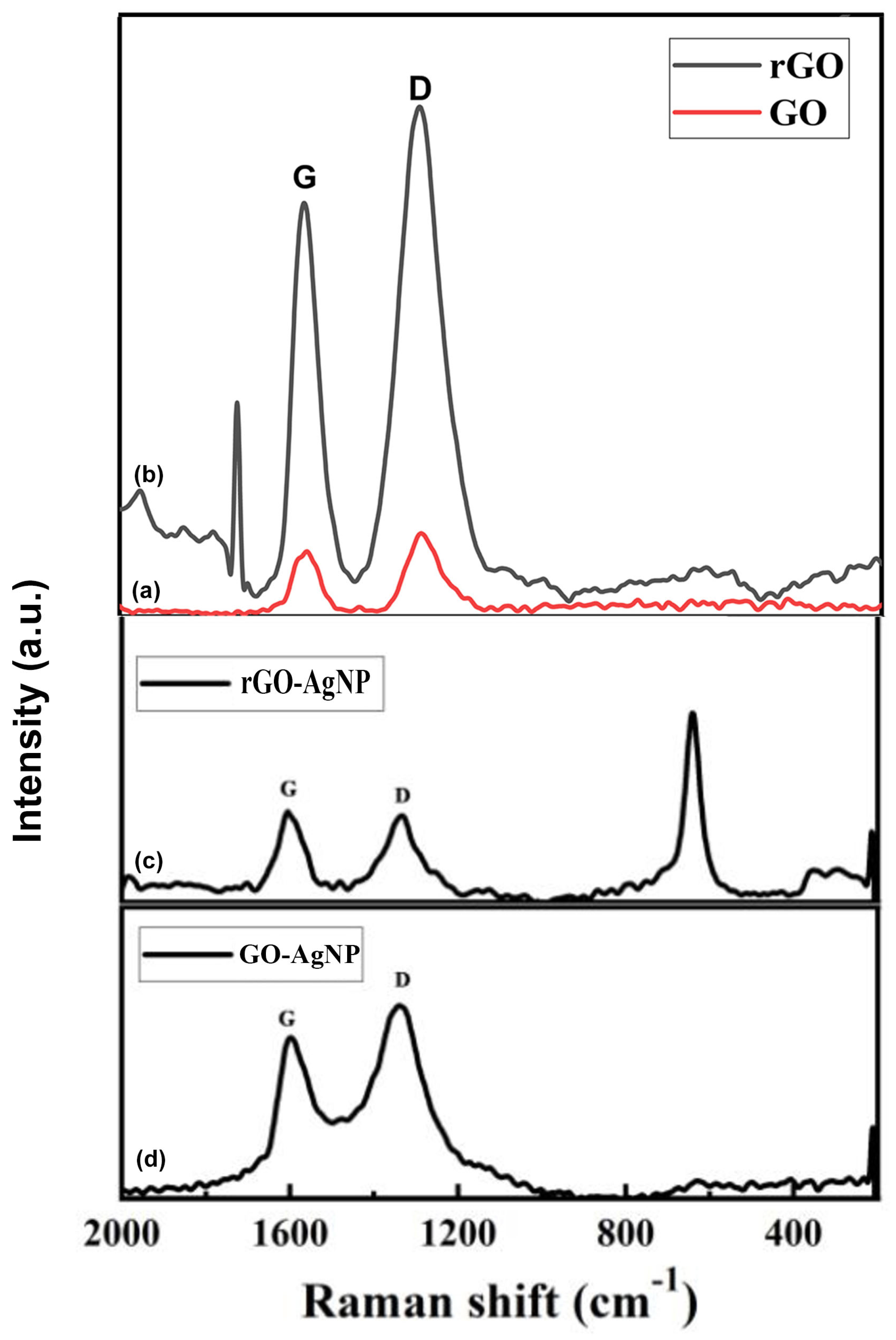



Disclaimer/Publisher’s Note: The statements, opinions and data contained in all publications are solely those of the individual author(s) and contributor(s) and not of MDPI and/or the editor(s). MDPI and/or the editor(s) disclaim responsibility for any injury to people or property resulting from any ideas, methods, instructions or products referred to in the content. |
© 2025 by the authors. Licensee MDPI, Basel, Switzerland. This article is an open access article distributed under the terms and conditions of the Creative Commons Attribution (CC BY) license (https://creativecommons.org/licenses/by/4.0/).
Share and Cite
Vimalanathan, B.; Thiyagarajan, D.; Mary, R.N.; Sachidanandam, M.; Ignacimuthu, S.; Gnanasampanthapandian, D.; Rajasingh, J.; Palaniyandi, K. Composites of Reduced Graphene Oxide Based on Silver Nanoparticles and Their Effect on Breast Cancer Stem Cells. Bioengineering 2025, 12, 508. https://doi.org/10.3390/bioengineering12050508
Vimalanathan B, Thiyagarajan D, Mary RN, Sachidanandam M, Ignacimuthu S, Gnanasampanthapandian D, Rajasingh J, Palaniyandi K. Composites of Reduced Graphene Oxide Based on Silver Nanoparticles and Their Effect on Breast Cancer Stem Cells. Bioengineering. 2025; 12(5):508. https://doi.org/10.3390/bioengineering12050508
Chicago/Turabian StyleVimalanathan, Babu, Devasena Thiyagarajan, Ruby Nirmala Mary, Magesh Sachidanandam, Savarimuthu Ignacimuthu, Dhanavathy Gnanasampanthapandian, Johnson Rajasingh, and Kanagaraj Palaniyandi. 2025. "Composites of Reduced Graphene Oxide Based on Silver Nanoparticles and Their Effect on Breast Cancer Stem Cells" Bioengineering 12, no. 5: 508. https://doi.org/10.3390/bioengineering12050508
APA StyleVimalanathan, B., Thiyagarajan, D., Mary, R. N., Sachidanandam, M., Ignacimuthu, S., Gnanasampanthapandian, D., Rajasingh, J., & Palaniyandi, K. (2025). Composites of Reduced Graphene Oxide Based on Silver Nanoparticles and Their Effect on Breast Cancer Stem Cells. Bioengineering, 12(5), 508. https://doi.org/10.3390/bioengineering12050508








